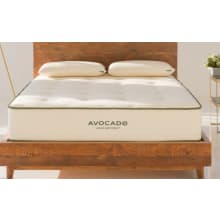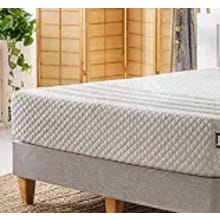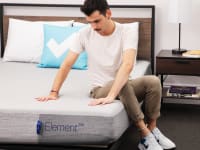Is there fiberglass in your mattress? Here’s what to know
Found in fiberglass mattresses, this flame retardant can cause health problems and property damage.
Products are chosen independently by our editors. Purchases made through our links may earn us a commission.
In 2022, California resident Vanessa Gutierrez filed a suit against South Korean mattress company Zinus, alleging that its popular “Green Tea Mattress” contained fiberglass that had resulted in nearly $20,000 in damages, including ongoing health problems and medical bills. Gutierrez’ suit, along with multiple lawsuits against the company, speaks to concerns about both fiberglass and other flame retardant materials in general.
But what exactly is fiberglass? The cheap plastic and glass material is found in mattresses sold by multiple companies and deemed safe if contained properly by other materials. What makes its use so controversial? Here’s what you need to know about fiberglass in mattresses and how to potentially protect yourself.
Why is there fiberglass in mattresses?
The internal structures of mattresses, like mattresses-in-a-box and hybrid mattresses, often include materials to promote heat diffusion, cushioning softness, and better support for the body. Mattresses also need to meet certain flame retardancy standards, ensuring they can resist and withstand sustained exposure to open flames.

These standards were set in 2007 by the U.S. Consumer Product Safety Commission, and require all mattresses to contain enough flame retardants to resist catching fire from a two-foot wide blowtorch flame for at least 70 seconds. One of the most commonly included materials to meet that requirement is fiberglass, a glass reinforced plastic. Fiberglass is inexpensive, and also avoids the use of flame retardant chemicals.
Using fiberglass as a cheap flame retardant for products isn’t new. It’s found in various furniture pieces, rugs, curtains, and the insulation of homes. Its materials are woven together to create a protective layer that can protect the more flammable properties of a mattress—such as memory foam—from potential exposure to an open flame. That interior layer is often covered by other materials and, of course, the actual exterior cover of the mattress.
But the lawsuit against Zinus alleges that fiberglass exposure has been linked to health issues and property damage, leaving many questioning the efficacy of its inclusion in mattresses and calling for a safer alternative.
Health concerns about fiberglass in mattresses
The use of fiberglass raises concerns about its potential health impacts, says Dr. Sabrina Barata, a primary care physician at Westlake Village Primary Care in Westlake Village, California. She explains that pieces of shards can leak out of a mattress, exposing people to the material. “Whether through simple wear and tear, washing, or any other factors that may disrupt the material, fiberglass can become airborne and can cause issues through inhalation or simple contact. Even on a new mattress, approximately 1% of fiberglass can migrate to the adjacent layers, increasing the risk of contact.”
Along with other flame retardants, fiberglass has been linked to adverse health effects. Its minuscule shards can settle across surfaces and spaces in a home and be difficult to remove without a professional—likewise, pieces of fiberglass can cause irritation to skin, eyes, and lungs. The issues caused by fiberglass exposure have led to lawsuits against mattress companies over the years.
“Its effect on your health is variable depending on the form of exposure and duration of its exposure. You may experience symptoms of coughing or sneezing as your body naturally attempts to rid of this material from your upper airway,” Barata says. While the irritation is usually temporary, Barata emphasizes that it can aggravate other respiratory issues, like asthma. She also notes that any significant concerns about fiberglass exposure should be addressed with medical providers.
Online groups like the mattresses sub-community on Reddit have also discussed fiberglass in mattresses. Many members have questioned what materials their mattresses contain and searched for fiberglass-free alternatives. In recent months, members have bought mattresses only to discover, while reading the label, that a certain component—like a cover—contains fiberglass.
Amid the lawsuit, a Zinus spokesperson cautions against removing any flame-retardant mattress covers: “To protect the internal fire barrier, customers should not remove the outer mattress cover. The label discloses the contents of the mattress and warns against removing the outer cover.”
What does fiberglass look like in a mattress?
Fiberglass is typically woven into a layer inside the mattress, meaning it’s only visible if you take off your mattress’ cover. The shiny, white, almost translucent material will most likely look like plastic threads. But because of fiberglass’ tendency to shatter and shed, it’s possible that smaller shards may fray from the woven layer. These shards are difficult to see and may leak out of the mattress or poke through the cover. Miniscule pieces can also become airborne and get into HVAC systems or be inhaled.
Typically, mattress labels list all of the materials included in the interior and exterior, including the cover. Barata says that reading these labels can be important for determining if, where, and how much fiberglass is located in the mattress. “If unclear, ask the manufacturer directly about the specific materials or components,” she suggests. Fiberglass may also be listed under other commonly used names, like glass-reinforced plastic, glass-fiber reinforced plastic, glass fiber, glass wool, or fiberglass-reinforced plastic. All mattress manufacturers are required to list every material used in both the inner and outer structures of their models, including a percentage of how much of each material is used in construction.
If a mattress contains fiberglass, the mattress tag should clearly state its location and recommend against removing the mattress cover. Mattresses and their covers also wear down over time, which means investing in a mattress protector could also help prolong protection.
Fiberglass-free mattresses you can buy instead
In recent years, many mattress companies have made concerted efforts to advertise their mattresses as fiberglass-free. This includes the Leesa Sapira Hybrid mattress, which was our best of the year (Leesa declared its entire catalog fiberglass-free last year) and the Avocado Green hybrid mattress.
Certain gold-standard material certifications, like the USDA Organic certification and Global Organic Latex Standard (GOLS) certification, can potentially indicate that a mattress doesn’t contain fiberglass, but it’s better to check the list of materials to be sure.





